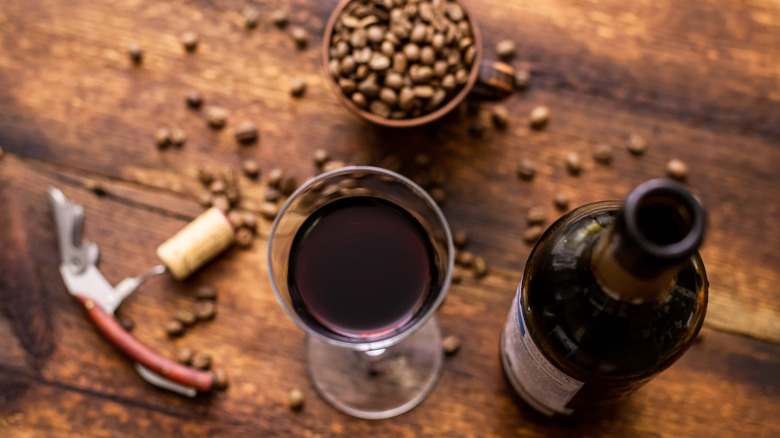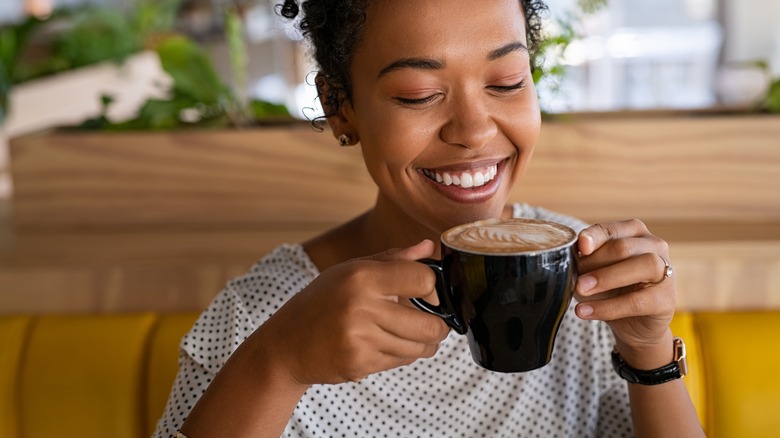The Process Of Tasting Coffee Is Similar To How You Taste Wine
Coffee and wine culture are powerful enough that some center their personality around them. Spunky adages like "Don't talk to me until I've had my coffee" and "I'm like wine, I just get better with age" are around for a reason." The fact that a "coffee-lover" archetype exists illustrates just how zealous real-life coffee fans can be. Picture a sweater-wearing java sipper in an exposed-brick cafe — one hand wrapped around a steaming mug, the other holding a Rimbaud anthology. The same cartoonish ideation is true of wine fans: Imagine a high-cheekboned fop limply swirling a long-stemmed glass of Lambrusco, and you begin to get the picture. To devoted fans, coffee and wine are more than just beverages.
The sommelier's world stretches far beyond just red wine and white wine; there are rosés, orange wines, sparkling wines, natural wines, and more. According to the International Organisation of Vine & Wine via Decanter, U.S. wine fans collectively enjoyed 3.31 billion liters in 2021.
In the same way, light and dark roasts are just the tip of the iceberg when it comes to coffee. This year, the New York Post reported that most American coffee fans savor two cups every day. There are Arabicas, Brazils, Ethiopias, Colombias, and more — and just like wine, each different coffee features idiosyncratic differences, from nuanced to distinct. It's perhaps fitting, then, that the process of tasting coffee is similar to how you taste wine.
The same basic structure and lexicon
The coffee-tasting lexicon is nearly indistinguishable from a sommelier's. Per Wine Enthusiast, descriptors like "fruit," "floral," "herbal," and "spice" are all common wine descriptors. Similarly, Prima Coffee encourages java sippers to taste for fruitiness, sweetness, acidity, and bitterness.
Both coffee-tasting and wine-tasting start with the nose. When tasting coffee Bean Box says to smell the beans before and after grinding, again after the grounds are bloomed with water, and once more before taking the first sip. (It's a lot of sniffing.) For tasting wine, The Spruce Eats says to swirl your glass for 10-12 seconds and gently inhale twice — first sharply, then deeply, nose nearly entering the mouth of the glass. Swirling coats the inside of the glass and introduces oxygen into the wine, which Food & Wine explains makes it easier to inhale its aromas.
Then comes the actual drinking. For coffee, says Java Presse, take small sips, allowing the coffee to spread across your tongue to fully taste it. For wine, The Spruce Eats also recommends small sips, letting it glide across the palette. During the active tasting process, Wine Enthusiast recommends keeping some specific criteria in mind: Sweetness, acidity, intensity, body, and the quality of the tannins and alcohols. For coffee, Bean Box offers nearly identical advice, saying that as you taste, evaluate for sweetness, acidity, body, and cleanliness (the way your palette feels after swallowing). The processes are all but indistinguishable, as are the words tasters use to describe them.
Why does a tasting process matter at all?
According to Food & Wine, wine is packed with a nearly dizzying array of unique flavor and aroma compounds. By embarking on the tasting process, fans are able to notice, identify, and experience more of these delicate features than they might get by slugging down a big gulp. But, believe it or not, coffee holds about twice as many flavor compounds as most wines, explains Bean Box. In fact, Verve Coffee Roasters identifies "Four Factors of Flavor:" Geography, variety, pressing, and roasting. The climate in which the beans are grown hugely influences their taste. According to Barista Institute, African coffees tend to be brighter and more acidic, Central American coffees often feature chocolate and caramel flavors, and Brazilian coffee is sweeter and more neutral. Location certain matters for wine as well; a Bordeaux wine differs from a Piedemonte for the same reason.
Still, considering coffee and wine are fundamentally different drinks, there is one key distinction that separates a successful coffee tasting from a wine tasting. Brewing technique is an irrelevant factor for wine sippers, since wine comes bottled and ready to drink. But, with coffee, sippers have to turn those beans into liquid before they can enjoy them. For the best coffee tasting, Bean Box recommends using the pour-over method, which will best bring out the delicate flavors in your beans.


